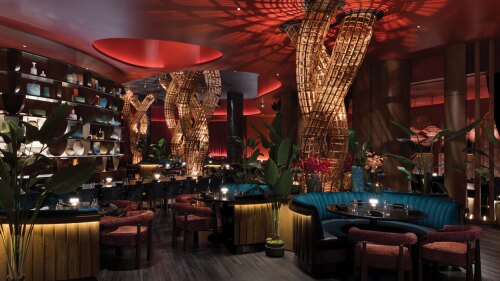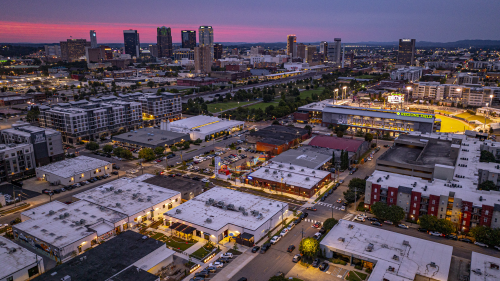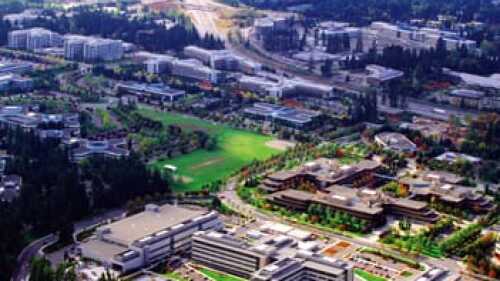Property Types
Hotels and Resorts
The hotel industry in the United States faces complex challenges in 2025, according to Jan Freitag, national director of hospitality analytics for the CoStar Group. During the “State of the U.S. Hotel Industry” presentation at the ULI 2025 Spring Meeting in Denver, Colorado, Freitag highlighted the challenges facing the hotel business amid macroeconomic uncertainty.
Once a sprawling expanse of uncharted land, Las Vegas, Nevada, has evolved into the entertainment capital of the world, a gaming super-hub, and a premier destination for sports. This remarkable transformation didn’t happen overnight; it stemmed from decades of strategic planning, investment, and visionary zoning recommendations.
Las Vegas is unlike any other place in America. Each year it draws more than 40 million visitors to the dazzling casinos and hotels that “turn night into daytime”—and transform the city into a glittering jewel in the desert. With 164,000 hotel rooms, Las Vegas is the largest hospitality market in the U.S.—outpacing Orlando, Florida, the next biggest market, by approximately 15 percent, according to JLL.
Industrial
Standing in the shadow of Regions Field and within earshot of Railroad Park, Birmingham’s Urban Supply hints at what the next chapter of downtown life could look like. Once-quiet brick warehouses are being steadily reimagined into patios, storefronts, and gathering spaces along a new pedestrian alley. Early tenants have begun to open their doors, and programming is slowly bringing people into the district. While the project is still in its early stages, the framework is in place for a vibrant hub that will grow block by block in the years ahead.
What trends are shaping the future of the industrial sector? Four experts from ULI’s Industrial and Office Park Development Council talk about the industrial submarkets and property types that offer the greatest opportunities, challenges developers face in bringing new projects to market, ways artificial intelligence and emerging technologies are reshaping the sector, tenant priorities, and other key trends.
After a quiet first half of 2024, CMBS originations increased 59 percent in Q3 on a year-over-year basis, according to the Mortgage Bankers Association’s Quarterly Survey.
Mixed-Use
Parks are increasingly being viewed as fiscal drains that further endanger a mayor’s bottom line. To counter that view comes Alexander Garvin, thinker in the realm of cities and public spaces. Read a review of his book Public Parks: The Key to Livable Communities, in which he presents the rationale for considering public parks as fundamental components of the built environment.
To transform the city’s moribund central business district, municipal officials in Quincy, Massachusetts, are partnering with Street-Works—a development firm that specializes in the creation of mixed-use districts around public spaces. What’s unusual about the Quincy project, however, is that the private sector—rather than the public sector—is doing the heavy lifting upfront. Learn more.
“By integrating one of the oldest buildings in Milpitas within a new, high-density community, the city is able to grow while still maintaining the continuity and historic feel of its city center.” Read about the seniors’ housing project in California—honored in the 2009 ULI Awards for Excellence: The Americas competition—that inspired this description.
Multifamily
Nashville, the capital of Tennessee, now has one of the nation’s most successful home retrofitting campaigns—Go Green Nashville. It started two years ago as a small pilot initiative by the ULI Nashville Sustainability Committee, targeting an urban neighborhood within the city, and has now taken off. Read more to discover what has made this community-based initiative so successful and what lessons can be applied in your area.
The Commercial Mortgage Alert Trepp weekly survey of 15 active portfolio lenders remained unchanged during the most recent survey period with financing remaining available in the 5 percent +/- range.
According to multifamily industry leaders who spoke at the recent ULI Washington Real Estate Trends Conference, the multifamily housing market in Washington, D.C., and other top markets is so rich with investment opportunity that “there are no bad strategies right now.” Read what types of multifamily communities and developments the panel said are achieving market acceptance at present.
Office
Panelists at a recent ULI Washington event discussed both the benefits of increased biking and the opportunities developers have to make buildings more bike friendly.
Finding detailed information on buildings—as well as the companies and people associated with them—is expensive, time consuming, and often difficult. But a new website, Honestbuildings.com, is intended to make such information as easy to find—and relationships as easy to build—as it is to look up old college roommates on Facebook.
Private companies are going the last mile to ensure that their facilities are well served by transit. And they see it as a way to maintain their competitive edge.
Residental
The United States is in the midst of a diversity boom that could rival or even surpass that seen during the baby boom of the last half of the 20th century, demographer William Frey writes in his 2014 book Diversity Explosion. In a question-and-answer session, Frey discusses the implications of changing demographics on U.S. housing.
With 120,000 people flocking to cities every day, urban migration highlights the need for adequate shelter. The key challenge for providers of affordable housing in Asian cities is finding developable land and securing the capital to build housing on a massive scale, an international panel of housing experts said at the Habitat for Humanity Asia-Pacific Housing Forum in Hong Kong in September.
The shrinking supply of workforce and affordable rental housing in cities across the United States has sparked innovative financing vehicles from an array of real estate firms to preserve the units, helping stem the loss of an urgently needed product, according to a report released by ULI and NeighborWorks America.
Retail
For decades, civic leaders have tried to revitalize Market Street, San Francisco’s central thoroughfare, only to see their efforts founder. “I sometimes call it the great white whale of San Francisco,” says Eric Tao, managing partner at L37 Development in San Francisco and co-chair of ULI San Francisco. “Every new mayor, every new planning director, every new economic development director has chased that white whale.” This year, however, an international competition of ideas hosted and run by ULI San Francisco, with support from the ULI Foundation, generated fresh momentum for reimagining the boulevard. The competition drew 173 submissions from nine countries and sparked new conversations about the future of downtown San Francisco.
The OAK project began in 2009, when a development firm set their sights on the corner of Northwest Expressway and North Pennsylvania Avenue, the state’s most important and busiest retail intersection. As the region’s only parcel capable of supporting a vertically integrated project of this scale and density, that land represented an opportunity to create something truly special.
As aging retail continue to evolve, one increasingly popular trend has been to redesign malls as town centers—recalling a time when such commercial districts were the heart and soul of a community. Mall–to–town center retrofits are emerging throughout the nation, especially in suburban communities, where pedestrian-friendly, mixed-use environments are highly attractive to millennials now raising families.



















